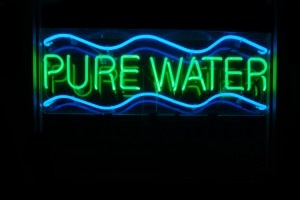Water, Water Everywhere
It’s getting very warm outside where I live and I see tons of people walking, running, or riding bikes with all kinds of water bottles and holders hanging off of them.
Water is great. It’s the main chemical component in your body and accounts for about 60% of your weight. Your body depends on water to do things like flush toxins out of your vital organs, carry nutrients to your cells, and supply a nice moist environment for your ears, nose, and throat.
How Much Should You Drink?
Eight glasses, ten glasses — how much? According to the Institute of Medicine, men should drink around 3 liters (about 13 cups) of fluids a day and women should drink 2.2 liters (about 9 cups).
What you eat can supply a significant portion of those fluids. Food supplies, on average, about 20% of your total water intake. For instance, fruit and vegetables, like watermelon and tomatoes, are 90% or more water by weight.
Drinks like juice and milk are contain mostly water. Beer, wine, soda, coffee, and tea also contribute. Your best bet is water because it’s cheap, calorie free, and available.
Bottled Or Tap?
One of the first questions you often hear in a restaurant is: “Bottle or tap”? The answer is not as straight forward as it might seem. According to CSPI’s Nutrition Action Healthletter (6/10):
- Theoretically, purified bottled water can be safer than tap because bottled water companies start with tap water that meets federal standards and then often treat it with UV light or ozone for additional disinfection and/or with reverse osmosis to remove chemicals.
- Tap water is just that – out of the tap, not from plastic landfill clogging bottles.
- The EPA regulates tap water and requires utilities to let consumers know when their water doesn’t meet standards.
- The FDA regulates bottled water and doesn’t require bottlers to notify consumers if water standards are not met.
- Tap water is free or pretty cheap.
Types Of Bottled Water: The Plain Stuff
The FDA requires the type of bottled water to be shown on its label.
Spring Water is from an underground formation that flows naturally to the earth’s surface and is collected only at the spring or from the underground formation that feeds the spring.
Purified Water is produced by distillation, deionization, reverse osmosis or other processes. It’s also called “distilled water,” deionized water,” or “reverse osmosis water.”
Mineral Water has specific proportions of mineral and trace elements when it emerges from its source. No minerals can be added.
Sparkling Bottled Water has the same amount of carbon dioxide in it that it had at its source. Sparkling bottled water can be labeled “sparkling mineral water,” “sparkling spring water,” etc.
Artesian Water/Artesian Well Water comes from a well that taps a confined aquifer (a water-bearing underground layer of rock or sand).
Well Water comes from a hole bored or drilled in the ground that taps a water aquifer.
Socialdieter Tip:
The choice is yours. Just be sure to drink an adequate amount of good, clean water and please try not to clog the landfills with plastic. I put some fresh mint from my garden into a pitcher of water in the fridge. Really refreshing. It’s a good idea to periodically check the potability of your water, especially if your water is supplied by a well. Mine is and when the seal on my well cap eroded the well got contaminated and had to be disinfected. Even my dog was drank bottled water for a couple of weeks. Municipalities often issue “boil water” alerts when their water sources show high bacterial contamination. Please don”t ignore these warnings – they are to protect you.
